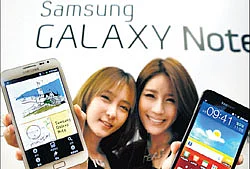It’s been likened to a piece of toast, a device for elephants and a throwback to the 1980s-style brick phone.

And yet, despite all the sniggering, Samsung Electronics has sold 5 million of the phone/tablet Galaxy Note, helping drive its booming handset profits in the quarter just ended.
More than a freak hit, consumer and design experts believe the surprise success of the “phablet” marks a deeper shift in the fast-paced world of mobile devices. The most obvious thing about the Note is its size. Its 5.3 inch (13.5 cm) screen is almost as wide as the iPhone's screen is long. And then there's the stylus.
Where Apple’s co-founder, the late Steve Jobs famously ridiculed the idea of using a pen to interact with a screen, Samsung has partnered with Japan’s Wacom Co Ltd, a market leader in digital pen technology, to come up with something less clunky. As part of Samsung’s marketing blitz it has set up artists in malls to draw portraits of passers-by.
Samsung says it hopes to sell at least 10 million Notes devices this year. But why, exactly, are people buying it?
Samsung’s Lee Jui Siang, mobile phone chief for Southeast Asia, Oceania and Taiwan, says people want to only carry one device — and especially one that allows handwriting. He points to a global survey of 5,000 smartphone users which indicated demand for handwritten annotations was particularly high in Asia.
But the Note’s designer sees things slightly differently. Samsung Vice President Lee Minhyouk said the design risk was “breaking a taboo” about keeping handsets small enough to fit easily in your hand.
“Smartphones are more about entertainment. The Note was created by simply breaking that taboo and focusing more on the new functions that smartphones require,” Lee told Reuters.
Mature & diverse
The Note has its detractors. It’s a “polarising device”, says IDC analyst Melissa Chua. But others say this misses the point. What the Galaxy Note has illustrated, design and industry experts say, is that as the mobile device market matures, it opens up the possibility of greater diversity as users and manufacturers experiment with form factors.
“We’re seeing a shift in the marketplace and there’s room for diversity,” says Shivesh Vishwanathan, senior solutions architect at Persistent Systems. “Smartphone devices are personal to people and are being used in unique ways — which explains why we’re seeing some strong reactions for as well as against ‘phablets’.”
For Samsung, it’s not just a boost to the bottom-line, but also a glimpse of a bigger prize. The Note suggests Samsung, which last year became the world’s top smartphone maker, may have found a way to eat into the tablet market, where it remains a distant second to Apple’s iPad.
While competitors try to catch up — LG Electronics has recently unveiled the 5-inch Optimus Vu — Samsung is already forging other niches.
It has just introduced the Galaxy Pocket, with a 2.8-inch screen, and websites are awash with speculation that the Galaxy SIII, due for launch in the next few months, will have a 4.8-inch screen, halfway between the SII and the Note.